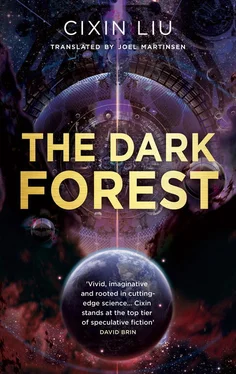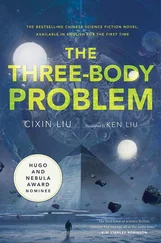But what was happening now overwhelmed all of that. The probe having “gone out” meant that its engines had turned off. Two years before, far beyond the Oort Cloud, the probe had begun to decelerate, which meant that its engine had started up in a sun-facing direction, enabling the space telescope to track the probe by engine light. Now that the light had gone out, tracking was no longer possible, because the probe itself was far too small—probably no bigger than a truck, based on the wake it left crossing the interstellar dust. An object that small out on the periphery of the Kuiper Belt, no longer emitting its own light and reflecting the weak light of the distant sun even more weakly—even a telescope as powerful as Ringier-Fitzroy couldn’t see such a tiny dark object so far off in the darkness of space.
“The three fleets don’t know how to do anything but struggle over power. This is just perfect—the target’s been lost….” Kuhn grumbled, waving his arms for emphasis. He forgot the station was now in a weightless state, and his movements caused him to perform a somersault.
For the first time, General Robinson did not defend the fleet. The Asian Fleet had originally dispatched three light, high-speed ships to track the probe at close range, but after the dispute erupted among the three fleets over the right to intercept, the Joint Conference had issued a resolution recalling all craft to base. The Asian Fleet repeatedly protested that the three fighter-class spaceships had been stripped of all weapons and external equipment and were carrying a crew of just two people each to achieve maximum acceleration for tracking the target, and even so, they could not possibly intercept the probe. However, the European and North American Fleets were unconvinced, and insisted that all spaceships in transit be recalled and replaced by three spaceships dispatched by Earth International as a fourth party. If not for that, the fleet ships would already have made close contact with the probe and begun tracking it. Earth’s ships, dispatched by the European Commonwealth and China, had not even passed the orbit of Neptune.
“Perhaps. Its engines might start up again,” the general said. “It’s still traveling pretty fast, and if it doesn’t decelerate it won’t be able to rest in solar orbit. It’ll pass right through the Solar System.”
“Are you the Trisolaran commander? Maybe the probe wasn’t ever planning on remaining in the Solar System, but was just going to pass through anyway!” Kuhn said. Then a thought suddenly struck him. “If the engines are off, then it can’t change course! Can’t you just figure out where it’s headed and send the tracking spacecraft to wait for it?”
The general shook his head. “That’s not precise enough. It’s not like an air force search in Earth’s atmosphere. One miniscule error, and you’ll be hundreds of thousands or even millions of kilometers off course. In such a huge area, the tracking craft won’t be able to find such a tiny, dark target…. But we’ve got to come up with a way somehow.”
“What can we do? Let the fleet figure it out.”
The general turned tough. “Doctor, you’ve got to realize the nature of the situation. Even though this isn’t our fault, the media won’t care. The Ringier-Fitzroy system was, after all, responsible for tracking the probe in deep space, so a good portion of that dirty water is going to land on our heads.”
Kuhn said nothing, but remained with his body perpendicular to the general’s for a while. Then he asked, “Is there anything else outside Neptune’s orbit that could be useful?”
“For the fleet, probably nothing. For Earth…” The general turned to ask the duty officer and soon learned that the UN Environmental Protection Organization had four large ships near Neptune, working on the early stages of the Fog Umbrella Project. The three small craft newly tasked with tracking the probe had been dispatched from those ships.
“And they’re there to mine oil film?” Kuhn asked. The reply was affirmative. Oil film was a substance found in Neptune’s rings. At high temperatures, it turned into a rapidly diffusing gas that then condensed into nanoparticles in space, forming space dust. It was so called because when it evaporated, it became highly diffusive, so a small quantity of the substance could form a large patch of dust, like a tiny droplet of oil spreading into an oil film of molecular thickness across a large area of water. Dust formed from this oil film had another property: Unlike other types of space dust, “oil-film dust” was not easily dispersed by the solar wind.
It was the discovery of oil film that made the Fog Umbrella Project possible. The plan was to use nuclear blasts in space to evaporate and spread the oil-film substance into a cloud of oil-film dust between the sun and Earth as a means of decreasing the sun’s radiation on Earth and alleviating global warming.
“I remember there’s supposed to be a stellar bomb near Neptune orbit from before the wars,” Kuhn said.
“There is. And the Fog Umbrella spaceships brought along a few, too, for blasting Neptune and its satellites. I’m not sure of the precise number.”
“I’d say one is enough,” Kuhn said excitedly.
Like Wallfacer Rey Diaz had predicted two centuries prior when he developed the stellar hydrogen bomb for his Wallfacer plan, although the weapon would be of limited use in the Doomsday Battle, the major powers wanted it to prepare for the possible outbreak of interplanetary war between humans. More than five thousand bombs had been manufactured, mostly during the Great Ravine, when international relations grew volatile due to lack of resources, and humanity was pushed to the brink of war. When the new era dawned, the horrifying weapons became dangerous nonessentials that were kept in storage in outer space, although they still belonged to countries on Earth. A few of them were blown up in planetary engineering projects, and another set was sent into orbit in the remote Solar System with the notion that the fusion materials could supplement the fuel of long-range spacecraft. However, because of the difficulty involved in dismantling the bombs, this idea was never realized.
“Do you think it’ll work?” Robinson asked, his eyes aglow. He was a little rueful that he hadn’t thought up such a simple idea himself, and that Kuhn had snatched the opportunity to go down in history.
“Give it a try. It’s the only thing we’ve got.”
“If your idea works, Doctor, then the Ringier-Fitzroy Station will forever revolve fast enough to generate Earth gravity.”
* * *
“It’s the biggest thing humanity has ever made,” the commander of Blue Shadow said, as he looked out the spacecraft’s window into the pitch-black of space. Nothing was visible, but he tried to convince himself that he could see the dust cloud.
“Why isn’t it lit by the sun, like the tail of a comet?” the pilot said. He and the commander were the only crew on Blue Shadow . He knew the density of the dust cloud was as thin as a comet’s tail, or about the same as a vacuum created in an Earth-based laboratory.
“Maybe the sunlight is too weak.” The commander looked back at the sun, which, in the lonely space between Neptune’s orbit and the Kuiper Belt, looked like a large star, its disc shape only barely distinguishable. Still, even the weak sunlight could still cast shadows on the bulkhead. “Besides, a comet tail is only visible from a certain distance away. We’re just at the edge of the cloud.”
The pilot tried to conjure up a mental image of the thin yet gigantic cloud. A few days ago, he and the commander had seen with their own eyes how small the cloud was when compressed into a solid. At the time, the giant spaceship Pacific had arrived from Neptune and left behind five things when it stopped in this section of space. The Blue Shadow ’s mechanical arm first retrieved a stellar hydrogen bomb from the early days of the war, a cylinder five meters long and a meter and a half in diameter. Next it picked up four large spheres between thirty and fifty meters in diameter. The four spheres, the oil film harvested from Neptune’s rings, were placed at points several hundred meters from the bomb. Once Pacific had departed the vicinity, the bomb exploded, forming a small sun whose light and heat surged into the cold abyss of space and instantly vaporized the surrounding spheres. The gaseous oil film diffused rapidly under the typhoon of H-bomb radiation, then cooled into countless tiny particles of dust, forming a cloud. The cloud had a diameter of two million kilometers, greater than that of the sun.
Читать дальше












